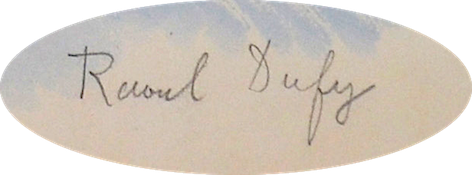

(Le Havre, 1877 - Forcalquier, 1953)

Since 1893, Raoul Dufy took an evening class of Charles Lhuillier at the Municipal Beaux-Arts Academy in Le Havre. He obtained in 1899 a grant from the city of Le Havre, which will allowed him to be admitted to the studio of Léon Bonnat, in the Beaux-Arts Academy in Paris. By this time, he met Othon Friesz with whom he shared a studio in Montmartre. In 1900, he entered National of the Beaux-Arts Academy in Paris with Othon Friesz. He draws a lot. His first exhibition occurs in 1901 at the Salon of French Artists. In 1903, he exhibited at the Salon of Independents. He painted a lot around Le Havre, especially in Saint–Adresse beach, famous thanks to Eugène Boudin and Claude Monet.
Influenced by fauvism, especially by Matisse’s paintings, he works with Friesz, Lecourt and Marquet, painting streets with flags, festivals and beaches. In 1908, becoming aware of Cézanne importance in a retrospective in 1907, he subsequently abandoned fauvism. He made studies of trees, horses, models in studio and still life paintings. The same year, he went to Estaque, near Marseille, with George Braque. The two painters paint often side-by-side the same patterns as Cézanne.
He started to frequent horse races and admired the aesthetic vision of horses, audience and movements. He travelled a lot and discovered Italia (Venice, Florence, Rome, Naples and Sicilia), Morocco, Spain (he admired Titian’s painting in Prado Museum), Belgium and England. He also stayed in Nice from 1925 to 1929 with his wife.
In 1926, watching a little girl running on the quay in Honfleur, he understood that mind records faster colours than contours. So he dissociates colours from drawing. He adds colour strip (usually three) or large coloured stains to his drawing.
In 1936 – 1937, with the help of his brother Jean Dufy, he realised the bigger painting of the world for the Pavilion of Electricity in the International Exhibition: Electricity fairy (624 square meters), actually in Musée d’Art Moderne de la Ville de Paris.
Raoul Dufy excels for theatre decorations and costumes. He notably made some for the Comédie Française. Dufy also illustrated Terrestrial Food by André Gide in 1949, than Colette’s Herbarium (1950). During these years he abandoned progressively the large colour stripes for a dominant tint
Raoul Dufy started to be ill and took shelter to south of France beginning 1940’s. He is promoted Commander of Legion d’Honneur. In 1952, forty-one paintings are sent via France to Venice Biennale where Dufy won Painting Prize and offered the amount to an Italian painter and to Charles Lapicque. Dufy settled in Forcalquier (Haute – Provence). He died in March 1953.